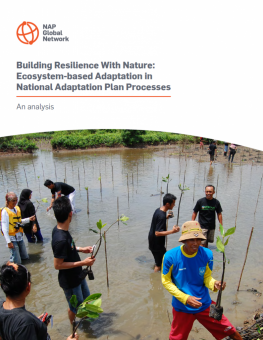
Building Resilience With Nature: Ecosystem-based Adaptation in National Adaptation Plan Processes
After reviewing 19 NAP documents, this analysis provides a better understanding of the extent to which EbA, as a tool for adaptation, can be integrated into NAP processes.
Healthy and resilient ecosystems are recognized in various international bodies and agendas, including the Paris Agreement, the Sustainable Development Goals (SDGs), the Sendai Framework for Disaster Risk Reduction, Convention on Biological Diversity (CBD) and the United Nations Convention to Combat Desertification. Specifically, ecosystem-based adaptation (EbA) as a nature-based solution is gaining importance since it recognizes that ecosystem services help reduce communities’ vulnerability to climate change. EbA can generate social and economic returns and provide multiple benefits—including improved health, biodiversity protection, food security, and alternative livelihood opportunities, all of which can build resilience to climate change.
National Adaptation Plan (NAP) processes present a strategic opportunity to raise the profile of EbA approaches, providing a framework—and, potentially, financial resources—for implementation at scale. Based on this , the NAP Global Network undertook an review of 19 NAP documents to better understand the extent to which EbA, as a tool for adaptation, has been taken up in NAP processes. This analysis highlights the extent of integration and identification of ecosystems and EbA into NAPs, trends in how EbA was incorporated, and opportunities to strengthen the profile and quality of EbA.
You might also be interested in
How Can We Work With Nature to Tackle Drought and Desertification?
Drought is one of the most devastating and pervasive challenges exacerbated by climate change. However, we can work to reduce its effects through nature-based solutions for land restoration and climate-smart agriculture.
Emirates Leaders Declaration at COP 28 an Important Step in Advancing Resilient Food Systems
IISD welcomes the Emirates Leaders Declaration on Sustainable Agriculture, Resilient Food Systems, and Climate Action announced today at the 28th UN Climate Change Conference (COP 28).
Food Systems and Agriculture: What’s on the menu for COP 28?
Our agriculture expert Claire McConnell explains the importance of food systems transformation in addressing climate change and how can it be achieved, particularly within the context of COP 28.
Five Ways the Global Goal on Adaptation can Help Build a Global Monitoring, Evaluation, and Learning System for Adaptation by COP 28
With the 58th meeting of the United Nations Framework Convention on Climate Change’s (UNFCCC) Subsidiary Bodies (SBs) due to kick off in Bonn, Germany, on June 5, one of the key issues to watch in the realm of climate change adaptation are the talks on the Global Goal on Adaptation (GGA).